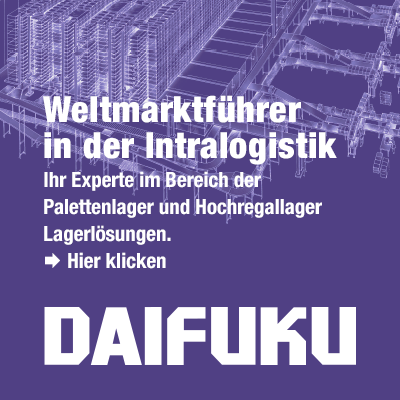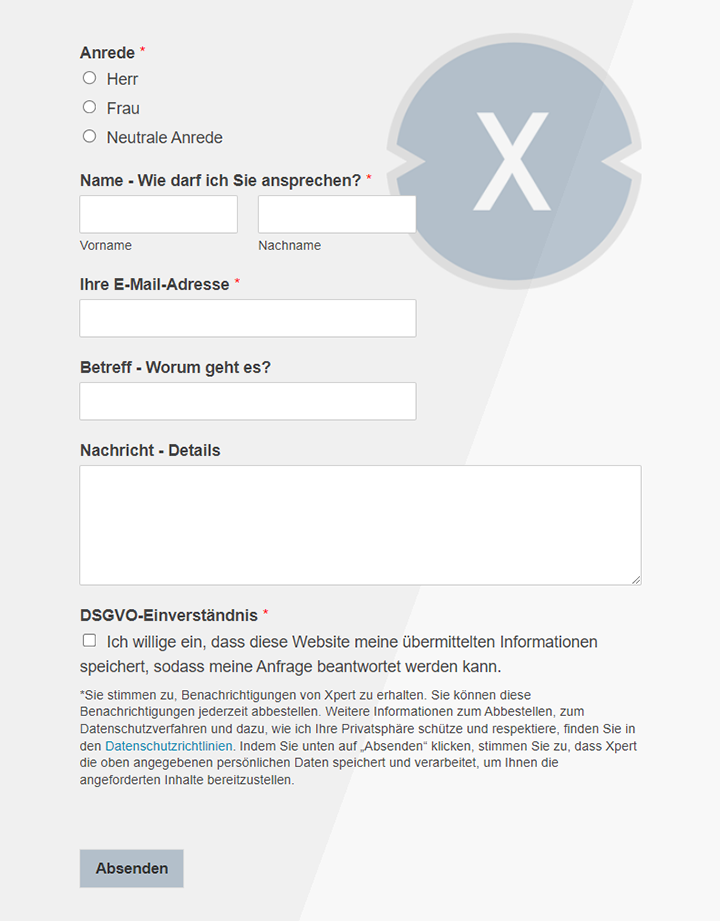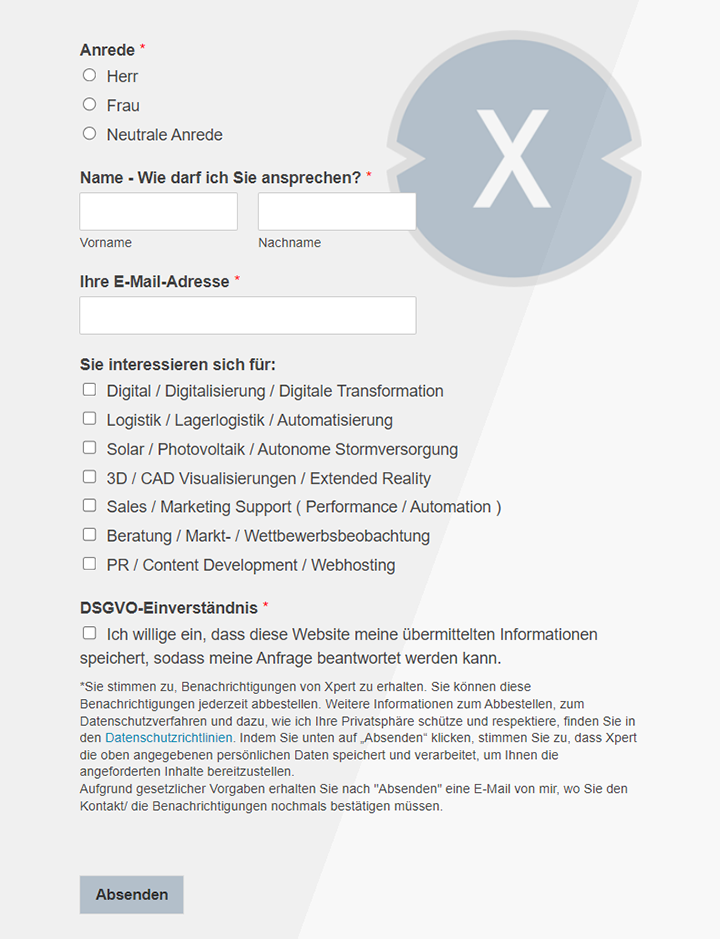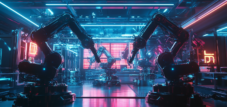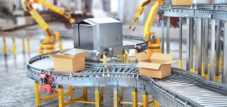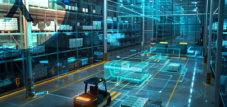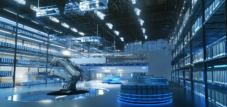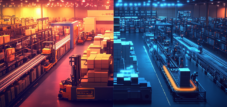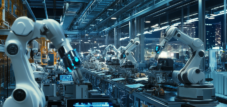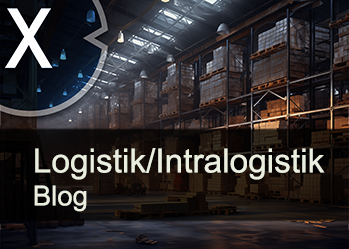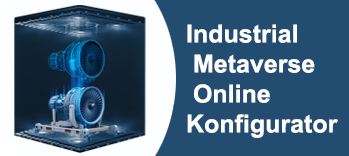Efficient planning and implementation: AI, robotics and automation in modern storage structures
Xpert pre-release
Language selection 📢
Published on: January 25, 2025 / update from: January 25, 2025 - Author: Konrad Wolfenstein

Efficient planning and implementation: AI, robotics and automation in modern storage structures - Image: Xpert.digital
Modern warehouse optimization: Automation as a key to success in e-commerce & Co.
Modern warehouse optimization: Automation as a key to success in e-commerce & Co.
The modern logistics landscape is changing rapidly. Companies that want to preserve their competitiveness are faced with the challenge of continuously optimizing their warehouse processes and adapting flexibly. In this context, artificial intelligence (AI), robotics and automation play an increasingly important role. Many industries and business models, especially in the area of e-commerce, automotive, trade and production, are increasingly relying on intelligent, automated warehouse processes to improve speed, precision and cost structures. The enormous potential that can be explained by a well-thought-out use of AI systems, modern robots and automation technologies is particularly evident in different storage types such as passage bearings, buffer camps and long-term camps. In the following, there is a comprehensive overview of how companies can benefit from these technologies, which specific requirements are placed on individual storage types and what can be a successful implementation. The aim is to present both basic concepts and practical implementation tips in order to achieve better results in warehouse planning and leadership.
Suitable for:
1. Meaning of the warehouse processes in the supply chain
Warehouse processes are a central element in every supply chain. In many companies, the words "efficiency and speed" are essential success factors. Because if goods are not available in time, this can result in production failures, delivery delays or dissatisfied customers. At the same time, warehousing must not be too cost -intensive because storage areas, energy and personnel cause high running costs. Especially in dynamic markets, it depends on smooth coordination, in which the supply and demand coincide as precisely as possible. Modern technologies help to avoid bottlenecks and largely automate processes. In the long term, the supply chain can benefit at all levels: from receipt of goods to picking to shipping.
In addition, camps play a strategic role in the buffering of fluctuations. For example, if the demand for a product increases unexpectedly, sufficient inventory and efficient infrastructure are required to use this need. In such cases, AI-based forecasts can make precise predictions so that on the one hand no bottlenecks arise and, on the other hand, unnecessary excess stands are avoided. Robotics and automation complement this approach by carrying out physical work faster, more precisely and often more cheaply than manual processes would enable. This makes it clear that only the interaction of AI, robotics and automation enables holistic process improvement.
2. AI as the driver of warehouse optimization
Artificial intelligence is considered a crucial driver for optimizing warehouse processes. From a historical point of view, warehousing was planned for a long time using static methods, in which recurring patterns and average values served as the basis for all decisions. Today, algorithms and large amounts of data can be used to draw much more precise conclusions. In this way, a AI can recognize complex relationships that a person with a lot of experience could hardly reproduce in this form.
Intelligent warehouse management systems
A heart of modern warehouses are intelligent warehouse management systems, which are often referred to as the "brain" of a warehouse. You are constantly collecting data-for example from scanners, sensors or ERP systems-and evaluating them using algorithms in real time. This creates a digital twin of the warehouse environment in which every movement of goods, robots and employees is understandable. This enables a dynamic storage space distribution: Depending on the properties such as size, weight or envelope frequency, the system assigns an optimal storage space for each product. In this way, the picking trails are shortened, the use of space is maximized and unnecessary empty driving.
Another example of the performance of AI in warehouse management systems is inventory optimization. Where previously rough estimates dominated about future needs, the system today analyzes historical sales data, seasonal fluctuations and external influences (for example through marketing campaigns or special action days) and automatically adapts the inventory. The advantages are obvious: missteps become less common, delivery times are shortened, and the capital, which would be bound in too large stocks, can be used elsewhere.
Efficiency increase through data analysis
In addition to the immediate advantages of inventory management and storage management, AI opens up new possibilities in the field of process optimization. For example, she can help to dynamically adjust picking routes. Instead of rigid picking lists, the system can analyze the current situation in the warehouse and determine the order of the articles to be picked in such a way that the paths are as short as possible and any traffic jams are avoided. "This often increases throughput and efficiency," is the experience of many experts who have implemented AI in their camps.
Predictive maintenance is another area in which data analysis plays a key role. Many machines and systems in a warehouse are equipped with sensors, the operating data records in real time: temperatures, vibration patterns, oil stands and much more. With the help of AI, indications of soon failure can be seen. In this way, maintenance can be carried out in critical bodies before serious damage occurs. This reduces downtimes, increases the lifespan of the machines and ideally saves repair and follow-up costs.
3. Robotics and automation for physical efficiency
While AI algorithms optimize the digital level of a warehouse, robots and automated systems create additional efficiency at a physical level. They take repetitive or physically exhausting activities and are able to perform consistently high around the clock. It is important that humans and machines cooperate optimally in order to use the advantages of both “actors”: the flexibility and creativity of humans as well as the endurance and precision of machines.
Automated conveyor systems
Funding systems form the logistical backbone in many camps. They transport goods from the entrance to the warehouse, from there for picking and finally to the packaging or shipping area. Traditionally, stationary conveyor belts or rail systems were used, which were only adaptable to a limited extent. Today, more autonomous mobile robots (AMR) are used, which navigate freely and without rail guidance in the warehouse. "Modern AMR find their way using sensors, laser or camera technology," is often reported. This enables you to react independently to obstacles and adapt your route at short notice. This leads to a more flexible design of the flow of goods.
Another form of automated support systems are driverless transport systems (FTS). These are particularly suitable for larger loads and predetermined routes, for example in standardized processes in production environments. FTS can be guided by markings on the ground, magnetic strips or modern navigation processes. In both cases, there is an advantage that material rivers designed much more evenly and human errors such as driving detours or incorrect placing goods can be minimized.
Order picking robots and cobots
A central step in the warehouse is picking, i.e. the compilation of goods for production orders or customer orders. The conventional image of an employee who runs through shelf rows with a hand scanner and collects articles is increasingly changing. Specialized picking robots or so-called collaborative robots (cobots) are used more and more. Commissioning robots have highly developed gripping and recognition systems: With AI-based image recognition, you can identify products in different sizes, shapes or packaging, reach and lay in containers. This enables quick and precise processing of orders.
Cobots, on the other hand, are designed to work in the immediate vicinity of people without being needed. Your movements are correspondingly slower and safer, so that they do not pose any danger to human colleagues. This cooperation leads to higher productivity because recurring or ergonomically unfavorable tasks are taken on by the cobots, while employees can perform more complex and difficult to automate activities. Such an interaction not only increases throughput, but can also increase job satisfaction because physically exhausting tasks are reduced.
Suitable for:
4. Specific solutions for different types of storage
Not all camps are the same. Your orientation, your requirements and the processes differ depending on the length of stay and how the stored were. A distinction is often made between the passage lagers, buffer camps and long -term camps. Each type of warehouse benefits from the technologies described in its own way.
Transit camp
The length of stay of the goods is very short in a passage camp. Here it is particularly important for speed and efficiency in the redistribution, for example if goods are directed directly to their next destination after the goods input, without being kept for a long time. Typically, the passage warehouse is a hub on which goods receipt and goods output are closely linked. Cross-docking methods are a frequently applied principle here, in which incoming deliveries based on specific customer or production orders are directly assigned to the outgoing tours.
Automated sorting systems are particularly valuable in this environment. With the help of conveyor belts, sorting systems and AI-controlled route optimization, goods currents can be channeled and priorities can be set. In this way, time -sensitive products that are quickly spoiled or urgently needed can be accelerated through the warehouse, while other articles are distributed in parallel into secondary lines. Minimizing throughput times is of crucial importance here. An intelligent algorithm recognizes, for example, which route is most busy and bypasses bottlenecks by choosing an alternative flow of goods. In this way, the coverage of a passage bearing can be significantly increased and the risk of congestion can be significantly reduced.
Buffer storage
Buffer camps are indispensable in many companies because they compensate for fluctuations between production and demand. If a production line continuously needs parts, but they arrive irregularly, the buffer warehouse ensures that there is always sufficient material. Conversely, excess products are stored in times of low demand in order to be available again later. The challenge is to be able to react flexibly to fluctuations without unnecessarily unnecessary storage space.
Shuttle systems are a common solution for buffer camps. These are automated shelf control units that drive in one or more levels on the shelf channel and were able to get in and out of it quickly. Such a high throughput is possible in a small space. AI systems support this process by assessing the goods requirements based on real-time information. If it is noticeable that production will take more parts shortly, stocks will be placed in the access areas in good time. This prevents manufacturing processes from standing because certain articles are missing. At the same time, these systems can be used in times of lower utilization to reorganize stocks and thus further increase efficiency.
Long-term storage
Long -term camps are often stored over a longer period of time, for example because they are subject to seasonal fluctuations, are rarely requested or are part of a strategic reserve. The optimization focuses more on the best possible use of space and precise inventory management. Automatic high -bay warehouse is a common solution to optimally use the vertical storage area. With the help of robot-controlled shelf control units, pallets can be stored and outsourced to large heights, which is particularly advantageous in expensive or spatially limited warehouse environments.
Intelligent inventory management in such long -term camps takes into account factors such as durability, demand forecasts and business key figures in order to achieve the best possible distribution of storage spaces. Articles that will soon have to be removed will be positioned further at the front or in easily accessible areas, while products are stored further up or back with a lower envelope. The goal is to stow away rarely used goods as space -saving as possible without access if it becomes necessary. AI systems can find the ideal balance here by developing dynamically customizable strategies and reacting to changed conditions.
5. Implementation strategies and challenges
The introduction of AI, robotics and automation in storage systems is best possible if it takes place gradually and well planned. Companies that try to radically change all processes in a short time often risk high costs, incorrect systems and lack of acceptance among employees. A pilot phase in which individual areas of the warehouse are equipped with new technologies serves to gain initial experiences and to recognize difficulties at an early stage. The successfully tested solutions can then be scaled and extended to other storage areas.
Scalability and flexibility
It is particularly important for growing companies that the new systems are scalable. An automated small division warehouse, which is designed for a certain amount of throughput, may be sufficient at the beginning, but can quickly reach its limits if the order volume increases sharply. Then additional robots or conveyor units should be able to be integrated without the entire system having to be decommissioned or re -planned. A flexible system architecture is therefore a crucial criterion when choosing providers and solutions. The software must also be modular so that new functions (e.g. additional sensors, new AI modules or improved picking strategies) can be easily added.
Integration into existing systems
Many companies already have ERP systems, warehouse management systems and various automation solutions. These have usually grown historically and have established themselves for years. When introducing AI and modern robotic solutions, it is crucial that the new tools fit seamlessly into the existing IT landscape. A well thought -out interface architecture is required so that all systems can communicate in real time. The importance of harmonized data is often underestimated. If, for example, article numbers, batch numbers or existing indicators are not maintained uniformly, incorrect stocks or false bills occur.
Integration can be challenging, especially in the area of robotics. Planning must ensure that the robots fit into the physical environment of the warehouse, for example by there are sufficient travel and charging stations. Security must also be guaranteed, for example by sensors on gates or automatic emergency off functions that protect people. At Cobots, the hurdle is lower here because they are explicitly designed for cooperation with people, but clear security guidelines should be defined.
Employee qualification and change management
An important factor for the success of warehouse automation lies in acceptance by the employees. "Initially, new technologies often ensure skepticism or rejection," is a common experience in practice. It is therefore important to involve the workforce at an early stage, to provide transparent information about the goals of the automation projects and offer training. Employees should learn how the systems work, what advantages they bring and how they can become part of the change. Anyone who understands early on that a robot is not a competition, but a relief for physically stressful tasks, tends to accept the innovations.
In addition, AI systems and automated processes often require a new competence profile. Instead of purely manual activities, IT knowledge, process understanding and technical know-how are increasingly required. Companies that continue to qualify their employees twice benefits: on the one hand, motivation increases, and on the other hand, errors in the application can be reduced. Successful change management takes into account fears and reservations, provides clear responsibilities and communicates success so that the project is accepted in the long term.
Data security and cybersecurity
An aspect that is often underestimated in practice is data security. "With the increasing networking of all camp components, the risks of cyber attacks also increase." If hackers penetrate the systems, they could not only steal data, but also sabotage production processes or paralyze entire warehouse operations. Therefore, companies must ensure the protection of sensitive information. This starts with encrypted data transmission and extends to sophisticated firewalls and continuous security updates.
The integration of external cloud services, for example for data evaluation or AI processes, carries other risks if not clearly defined where the data is, who has access and how a secure connection is guaranteed. In addition, every company should develop a clear emergency strategy that comes into force as soon as a safety incident is recognized. This includes emergency plans, backup systems and a quick restoration of the processes concerned. This is the only way to ensure smooth operation even if there are technical or organizational failures.
6. Economic consideration: costs and benefits
"Investments in robotics, AI and automation are a step into the future for many companies," says relevant industry circles. However, medium-sized companies in particular should carry out a careful cost-benefit analysis before they provide large sums to modernize their warehouse. A AI system for inventory optimization can result in considerable savings on storage costs, but initially requires extensive adjustments to IT systems and a targeted knowledge structure among employees. In the case of robots and driverless transport systems, the acquisition and maintenance costs are also added.
The benefit side includes improved delivery capacity, reduced picking times, lower error rates and higher availability of the systems. The scalability can also become a competitive advantage: if a company has to grow quickly, an automated warehouse is easier to adapt to higher cover volumes than a manually operated. In addition, employee satisfaction often increases when monotonous or difficult activities are eliminated and new, more interesting areas of responsibility arise. Overall, the advantages predominate in many cases as soon as the system runs stable and the initial additional effort is complete.
Suitable for:
7. New trends and future developments
The technologies in warehouse logistics develop at rapid speed. More and more systems are being networked, so that a consistent Internet of Things (IoT) is created. Sensors of pallets, load carriers or even products provide permanent data about the location, condition and the surrounding area. The warehouse becomes a cyberphysical system in which each movement is digitally mapped and analyzed. The AI can use this data for deeper forecasts, for example to control supply chains even more precisely or to recognize bottlenecks in advance. In the future, technologies such as Virtual Reality (VR) or Augmented Reality (AR) could also gain importance to support employees in training or picking.
Another trend is fully autonomous camps in which people only play a monitoring role. There are already pilot projects in which all storage movements of robots are carried out and AI systems make all decisions. People only intervene when there are disorders or exceptions. However, such an approach requires high -grade maturity of the technology and a very stable process environment. The future will show whether and in which industries completely autonomous camps.
At the same time, the logistics industry deals with topics such as sustainability and energy efficiency. AI systems can help plan routes so that less energy is used or storage processes in times of low electricity tariffs. Robots and conveyor technology are becoming increasingly energy -efficient and more powerful at the same time. Progress in sensors enable a precise overview of temperature, humidity and other environmental factors that are important for high -quality storage. This is particularly relevant for industries that store sensitive or perishable goods.
The integration of AI, robotics and automation in the passage warehouse, buffer warehouse and long -term camp has the potential to significantly increase the efficiency and flexibility of the entire supply chain. AI-supported warehouse management systems enable forward-looking inventory optimization, dynamic assignment of storage spaces and an ongoing process analysis. This increases increasingly precise control of all movements in the warehouse, which in turn reduces picking and envelope times. At the physical level, robots and automated support systems take over repetitive or difficult tasks, increase the performance around the clock and minimize errors. Thanks to cobots, cooperation between man and machine is possible, which enables new, more efficient work processes to be established.
In passage lagers, cross-docking systems and AI-controlled sorting processes shorten the length of the goods. Buffer bearings benefit from shuttle-based shelves that can react to production and demand fluctuations in real time. Long -term camps use fully automatic high -bay warehouse and intelligent inventory strategies to optimally exploit the existing room. These developments show that no company no longer comes to AI, robotics and automation if it wants to remain competitive in the long term. Nevertheless, companies should pay attention to a solid implementation strategy, sophisticated security concepts and a good involvement of the employees in order to draw the greatest possible benefit from the investments.
A look into the future shows that the technologies will continue to develop rapidly. The warehouse world will continue to change the warehouse world more and more powerful algorithms, closer networking of systems and new forms of human-machine interaction. It is therefore advisable to set the course for tomorrow and consciously deal with the opportunities and challenges in the company that offers a digitized and automated warehouse. In this way, companies can successfully master the step towards warehousing 4.0 and at the same time strengthen their market position. The "logistics of the future" is no longer a distant vision, but in many areas already lived reality - and it will become more and more a matter of course in the coming years.
With a well thought-out mix of AI-based planning tools, flexible robotics and integrated automation solutions, individual storage requirements can be perfectly covered. Decision -makers should always keep an eye on the overall picture: In addition to technological aspects, factors such as employee qualification, data integration, security and scalability are essential to ensure successful transformation. If all of these elements merged harmoniously, the warehouse can become a real value driver for the entire company instead of only acting as a necessary appendage. In other words, if you plan properly and efficiently today, lay the foundation for stable, powerful and future -oriented supply chains - and thus secure decisive competitive advantages in an increasingly digitized world.
Xpert partner in warehouse planning and construction
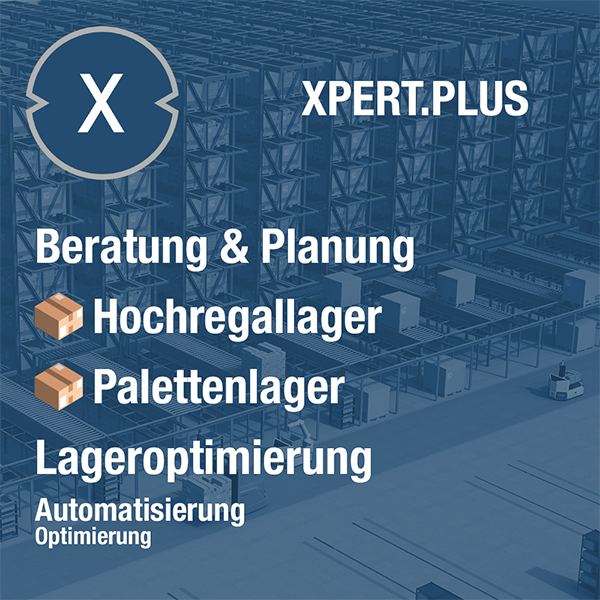
Xpert.Plus warehouse optimization - high-bay warehouses such as pallet warehouses consulting and planning
We are there for you - advice - planning - implementation - project management
☑️ SME support in strategy, consulting, planning and implementation
☑️ Creation or realignment of the digital strategy and digitalization
☑️ Expansion and optimization of international sales processes
☑️ Global & Digital B2B trading platforms
☑️ Pioneer Business Development
I would be happy to serve as your personal advisor.
You can contact me by filling out the contact form below or simply call me on +49 89 89 674 804 (Munich) .
I'm looking forward to our joint project.
Xpert.Digital - Konrad Wolfenstein
Xpert.Digital is a hub for industry with a focus on digitalization, mechanical engineering, logistics/intralogistics and photovoltaics.
With our 360° business development solution, we support well-known companies from new business to after sales.
Market intelligence, smarketing, marketing automation, content development, PR, mail campaigns, personalized social media and lead nurturing are part of our digital tools.
You can find out more at: www.xpert.digital - www.xpert.solar - www.xpert.plus



